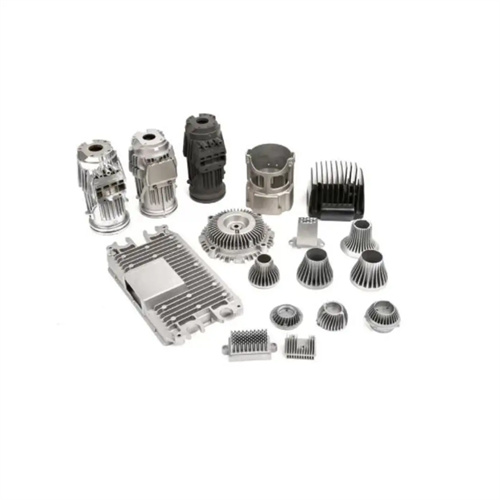Cleaning, shaping and repairing of die castings
Cleaning die-castings is essential for subsequent processing and use. Its primary purpose is to remove impurities such as oil, scale, paint residue, and debris generated during the die-casting process. This ensures a clean surface and creates optimal conditions for subsequent shaping, repair, and surface treatment. The cleaning process should be tailored to the casting material and the degree of surface contamination. Common cleaning methods include mechanical cleaning, chemical cleaning, and ultrasonic cleaning. Mechanical cleaning is suitable for removing burrs, flash, and larger debris from the casting surface. This can be achieved by grinding with tools such as wire brushes, sandpaper, and grinding wheels, or by using a shot blasting machine, which sprays steel shot at high speed onto the casting surface. The impact removes impurities while also creating a roughness that facilitates the adhesion of subsequent coatings. For aluminum alloy die-castings, use steel shot of moderate hardness to avoid excessive surface damage. Zinc alloy die-castings, due to their lower hardness, should be cleaned with finer steel shot or glass beads.

Chemical cleaning removes oil and scale by reacting chemical solutions with impurities on the casting surface. Common chemical cleaning agents include alkaline solutions, acidic solutions, and organic solvents. Alkaline solutions are suitable for removing animal and vegetable fats and mineral oils from the casting surface. Through saponification, the oils are converted into water-soluble substances. For example, sodium hydroxide solution is commonly used for degreasing aluminum alloy die-castings. Acidic solutions are primarily used to remove scale and rust. For example, nitric acid solution is effective for removing the oxide layer on the surface of copper alloy die-castings. However, the treatment time and temperature must be strictly controlled to prevent corrosion of the casting substrate. Organic solvent cleaning is suitable for removing oils that are difficult to remove with acid or alkali solutions, such as gasoline and alcohol. However, due to their high volatility and environmental pollution, they are gradually being replaced by water-based cleaning agents. After chemical cleaning, any residual solution on the casting surface must be rinsed with clean water to prevent continued corrosion from residual chemicals.

Ultrasonic cleaning is a highly efficient and precise cleaning method, particularly suitable for die-castings with complex shapes, deep holes, or narrow crevices. It utilizes the high-frequency vibrations of ultrasound waves within the cleaning fluid to form tiny bubbles that burst instantly, generating a powerful impact that removes impurities hidden within crevices and deep holes. Ultrasonic cleaning not only thoroughly removes surface oil and fine debris without damaging the casting surface, but also boasts cleaning efficiency several times greater than traditional methods. For example, ultrasonic cleaning can effectively remove residual metal chips and oil from die-castings of automobile transmission housings with complex internal cavities, ensuring that impurities prevent wear or failure of parts after assembly. The effectiveness of ultrasonic cleaning is closely related to the temperature and concentration of the cleaning fluid, as well as the ultrasonic frequency. Generally, optimal cleaning results are achieved by controlling the cleaning fluid temperature between 50-60°C and selecting a frequency between 20-40kHz.

Reshaping die castings involves restoring deformed castings to their specified dimensions and shape through external force or heat, ensuring they meet assembly precision requirements. The reshaping process is tailored to the degree of deformation and the material properties of the casting. Common reshaping methods include cold and hot reshaping. Cold reshaping is suitable for castings with minimal deformation. At room temperature, pressure is applied to the deformed area using a specialized reshaping die or fixture to induce plastic deformation and restore the correct shape. For example, a bent aluminum alloy die casting can be placed in a reshaping die, where a press applies a certain pressure for a period of time, utilizing the metal’s plasticity to achieve correction. Cold reshaping is simple and efficient, but for castings with significant deformation, excessive internal stress may cause cracking, necessitating hot reshaping. Hot reshaping involves heating the casting to a certain temperature (usually near the alloy’s recrystallization temperature) to increase the metal’s plasticity. External force is then applied through the die to correct the deformation. This method is suitable for castings with severe deformation or hard materials. For example, the shaping of magnesium alloy die castings is often performed by heating to 200-250℃ and then performing pressure correction, which can reduce the correction force and the risk of cracking.

Die-casting repair targets surface defects such as pores, shrinkage, scratches, and dents to improve the quality rate of the casting. The repair method should be selected based on the type and size of the defect. For small pores and scratches, a filling method can be used. A specialized repair compound (such as epoxy resin or metal powder putty) is used to fill the defective area. After polishing, the area is flush with the surrounding surface. The repair compound must have good compatibility and adhesion with the casting material to prevent it from falling off during use. For larger shrinkage or pores, welding can be used . TIG welding, for example, is suitable for repairing aluminum alloy die-castings. The arc melts the filler metal and fills the defect. After welding, polishing is required to ensure a smooth surface. However, welding repairs may cause localized deformation and structural changes, so caution should be used for defects in stress-bearing areas. For cosmetic defects that do not affect performance, mechanical removal methods, such as milling or grinding, can be used to remove the defective area to ensure that the casting meets quality requirements. Regardless of the repair method used, the casting must be quality inspected after repair to ensure that the performance and appearance of the repaired area meet the design standards.
